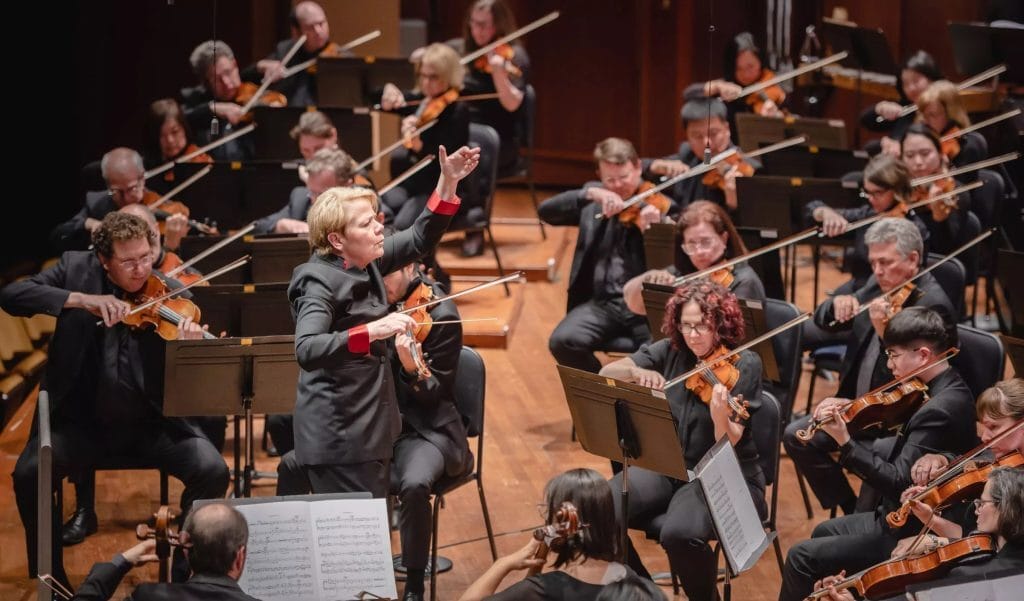- Gathering Note
- Posts
- Seattle Symphony’s season penultimate program celebrates Shakespeare’s Romeo and Juliet
Seattle Symphony’s season penultimate program celebrates Shakespeare’s Romeo and Juliet

Photo Credit Carlin Ma
The Seattle Symphony’s penultimate program of the 2022-23 season embraced the notion of music as a medium for artistic expression – with Shakespeare’s “Romeo and Juliet” at the center. This timeless tale has inspired many a composer, and guest conductor Marin Alsop led the orchestra in three of the most iconic interpretations of the star-crossed lovers and their sword-crossed clans. For the first half of the program, Alsop drew from the oeuvre of Tchaikovsky and her mentor Leonard Bernstein. But the zenith of artistic expression and enjoyment was doubtlessly the second half, with a captivating rendition of selections from Prokofiev’s celebrated ballet Romeo and Juliet.
Alsop made her debut with the Seattle Symphony back in 2005, a performance I recall fondly for a vibrant rendition of Tchaikovsky’s Second Symphony. Back then, after earning notoriety in the conducting world at Tanglewood and leading orchestras in Eugene and Denver, Alsop was just entering the public eye. Alsop was establishing herself as a leading interpreter of the music of Barber, Bernstein, and other American composers. And the performance came just a few months before she became the first conductor to receive a “genius grant” from the MacArthur Foundation. Several years later she would take the podium as music director of the Baltimore Symphony, joining JoAnn Falletta as one of a few women to lead a major American orchestra. And her reputation since then has rightly soared. But back then, it was her expert knowledge and swaying presence that seemed to delight the audience and orchestra alike, and what I looked forward to with her return.
Her expert knowledge of American music, she was set to shine with this return visit to Seattle. Initially, the program was to feature Bernstein’s Songfest, an orchestral song-cycle composed for America’s 1976 bicentennial. Alsop has been a significant figure in the restoration of Bernstein’s genre-defying religious theater piece, Mass, one of many reasons I was looking forward to hearing if she could do the same with Songfest — and just as important, if Seattle audiences would enjoy it. Regrettably, the piece was pulled, allegedly due to a scheduling conflict with one of the soloists.
The replacement works lacked the same allure as Songfest. Tchaikovsky’s Romeo and Juliet, renowned for its luscious and infamous melodies — as well as its intense action — has always been an audience favorite. Similarly, Bernstein’s Symphonic Dances from West Side Story combines all of the familiar orchestra bits from “West Side Story” into a concise suite. Both pieces were played well, the Tchaikovsky alternating between the tender and explosive intensity, while Bernstein’s dances dazzled with spirited brass, winds and percussion — as well as a striking solo from principal violist Susan Gulkis Assadi. However, despite the skilled execution, both compositions felt somewhat restrained. Personally, I longed for a more fervent interpretation from Alsop in Tchaikovsky and a richer palette of colors in Bernstein’s work.
Excerpts from Prokofiev’s Romeo and Juliet suites featured in the second half. The ballet the suites are drawn from is an iconic treatment of Shakespeare’s play equal to Tchaikovsky and Bernstein. Its numerous lilting sequences are justly beloved by audiences. Alsop pulled from Prokofiev’s suites to form a symphony-length survey of the ballet’s dramatic highlights. Her interpretation kept a firm grasp on each section’s essential dance character and marvelously balanced each section of the orchestra. Prokofiev’s most delicate moments, such as Juliet as a young girl, carried the same weight as the intense brutality of Tybalt’s death and the heart-wrenching sorrow of Juliet’s suicide.
The Seattle Symphony season draws to a close later this week with Mahler’s Second Symphony — conducted by another much-lauded and much-beloved guest conductor, Osmo Vänskä. It is that time of the year where most orchestras pull out all the stops to punctuate what has happened during the last nine months, while offering a preview of what audiences can hope for when the music returns in the fall. Alsop and the talented musicians of the Seattle Symphony showcased their immense potential in every piece. But unfortunately, her recent turn at the podium was also a lost opportunity. The audience was thrilled. She and the musicians were great. But the program was simply too ordinary for an ensemble whose management asks its audience to “listen boldly.”